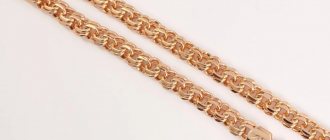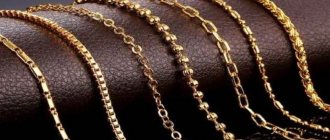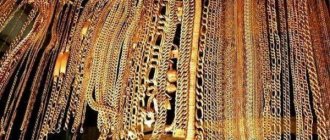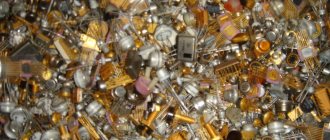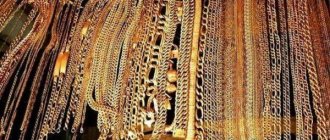Bracelets
- Style
- Size
- Body type
- Try
A bracelet is a popular piece of jewelry among women. The product is universal, it is worn by the fair sex of any age. An accessory can highlight the beauty of a lady and complement the created image with a bright touch.
But you will be able to achieve results if you follow the rules of choice: then the gold bracelet on your hand will speak of the owner’s impeccable taste, and the purchase will not be a disappointment.
Gold bracelets are not cheap, you need to take your choice seriously
Body type
Few people think about such nuances, but when choosing a bracelet, a person’s build is of great importance:
- Graceful, petite ladies can afford almost invisible string bracelets. Medium-sized jewelry with a complex design will also look good. Wide, bulky bracelets are suitable only if the product consists of “strings” - a solid accessory in this case will weigh down the figure and seem inappropriate. The bracelet should look light and weightless, be openwork - then girls with a graceful physique will look even more feminine.
- Ladies with curves should take a closer look at large bracelets. It’s good if the product is decorated with one large stone. Accessories with round links or decorated with rhinestones or many stones should be avoided; in no case should you purchase thin chains. An excellent model for plus size ladies are wristbands.
Bracelet made of white and rose gold, PUSHKIN JEWELRY FACTORY (price on the link)
- If a bracelet is chosen for a man, then it is also worth remembering the physique. For strong men, bracelets in the form of a chain with large links are suitable - it will be solid. For guys with a sporty figure, narrow strip bracelets are suitable. It is difficult for young, thin people to choose a suitable piece of jewelry: the accessory should not be narrow, so as not to make the hand look feminine, and not wide, as this will “cut down” the hand. It is important to choose a medium-sized product.
A little history of bracelets
The bracelet has a long history and has gone through more than one reincarnation before becoming a popular piece of jewelry. In terms of how long it has been worn, only the ring can compete with it.
Ancient people made hoop bracelets from animal veins and skin, and the prototype of the first pendants were animal fangs. Back then, hoops were multifunctional: they served as decoration, an amulet, and also protected a man’s wrist from blows and animal bites. Over time, all these roles merged into one - jewelry-amulets.
As time passed, materials and techniques for processing decorative items changed. Primitive bracelets were replaced by products made of metal and precious stones. They already performed a status function and were used in official ceremonies.
In Europe, bracelets entered jewelry fashion only in the 17th century, along with three-quarter sleeves. Bracelets were mainly worn by rich aristocrats at balls.
The beginning/middle of the 20th century saw the era of massive bracelets (cuff bracelets, watch bracelets). Women's bracelets made of pearl threads set the tone in classical fashion, and in non-classical fashion - chain bracelets and cuffs with multi-colored gems.
Size
Difficulties at the selection stage usually arise when determining the size of the bracelet. Some believe that the best option is when the bracelet fits tightly to the hand, while others, on the contrary, believe that the jewelry should be loose.
Stylists have their own opinion on this matter: the optimal gap between the bracelet and the skin should be 1-1.5 cm, maximum 3 cm. Such jewelry will not dig into the skin, dangle and interfere with movements, and the risk of accidental loss is reduced.
To determine the size in advance, you need to measure your wrist circumference. Add 1-1.5 cm to the result and find out what length the product is suitable for. Gold bracelets with heavy inserts should fit tightly to the hand, but not pinch it or dig into the skin. The maximum gap between the skin and the decoration is 0.5-1 cm.
If you are purchasing a bracelet as a gift, give preference to products consisting of links. If necessary, the recipient can easily correct the size at the jeweler: the specialist will add or subtract a few links, and the problem will be solved. Or purchase the option where the length is adjusted independently - there are many similar models now available.
Gold bracelet with diamonds, SL (price on the link)
Automatic weaving chains
In addition to hand knitting, the master can make chains using a machine or by stamping. Types of gold bracelets made using a machine:
- “Lav” - this weaving is used to create women's jewelry. It uses oval and rounded loops that emphasize the sophistication of a woman's hand. This bracelet will allow you to create a harmonious look in combination with any clothing.
- "Figaro", also called "Nona", is a type of shell weave. This type is distinguished by its unusualness - the elongated links are laconically intertwined with each other.
- "Singapore" is also a subspecies of shell weaving and is distinguished by complex spiral shapes. Thanks to the special arrangement of the links, the chain shines in the sun's rays.
- “Turtle” - each link in this weaving resembles a turtle shell. The design is considered durable, but the plates can cling to clothing, causing discomfort.
Making a chain using the stamping method involves using ready-made links that are threaded into each other. Such bracelets are cheaper, they quickly lose their original appearance.
Other types of hand weaving
A women's or men's gold bracelet can also be made to order. At the same time, the quality of weaving directly depends on the qualifications of the craftsman. The following types of bracelets are popular:
- “Venetian” weaving is distinguished by the use of rectangles in the design. Such bracelets are durable, and weaving is used to create massive bracelets. Accessories can be decorated with precious stones.
- “Arab” - weaving can be made either manually or by machine. Considered reliable and durable.
- “Rose”, also called “Courage”, - the weaving is distinguished by special links that are made in the shape of a spiral. The finished accessory looks voluminous and expensive.
- Python, also called Italian weave, is often used to make bracelets and other accessories. It is considered more of a feminine option, it looks sophisticated and elegant.
When making a men's or women's gold bracelet using hand weaving technology, a master chain maker manually solders each component of the chain. The weight of such an accessory is more than 6 grams, it is durable.
